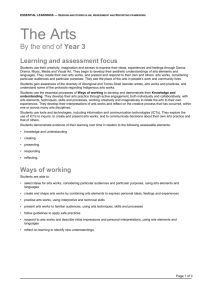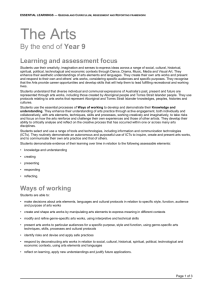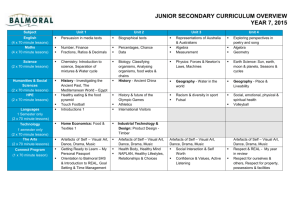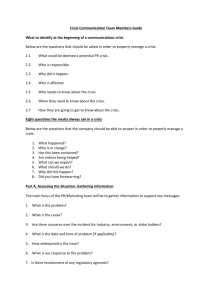DOCX, 72 kB - Queensland Curriculum and Assessment Authority
advertisement
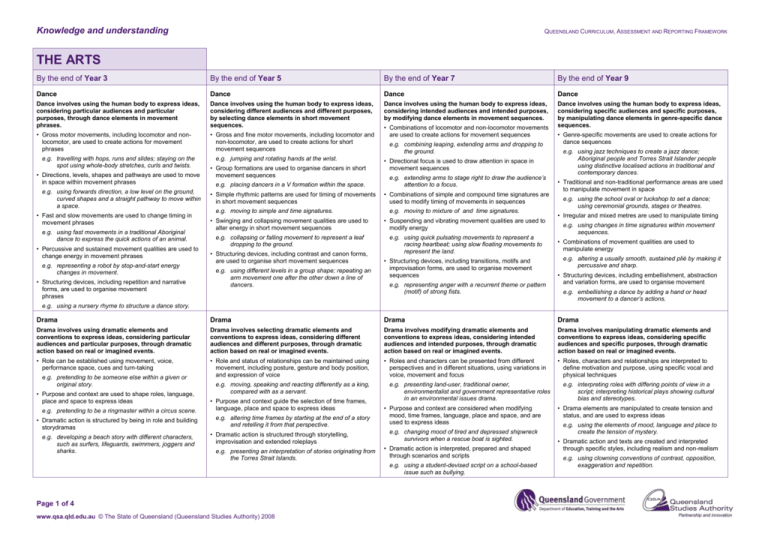
Knowledge and understanding QUEENSLAND CURRICULUM, ASSESSMENT AND REPORTING FRAMEWORK THE ARTS By the end of Year 3 By the end of Year 5 By the end of Year 7 By the end of Year 9 Dance Dance Dance Dance Dance involves using the human body to express ideas, considering particular audiences and particular purposes, through dance elements in movement phrases. Dance involves using the human body to express ideas, considering different audiences and different purposes, by selecting dance elements in short movement sequences. Dance involves using the human body to express ideas, considering intended audiences and intended purposes, by modifying dance elements in movement sequences. Dance involves using the human body to express ideas, considering specific audiences and specific purposes, by manipulating dance elements in genre-specific dance sequences. • Gross motor movements, including locomotor and nonlocomotor, are used to create actions for movement phrases • Gross and fine motor movements, including locomotor and non-locomotor, are used to create actions for short movement sequences e.g. travelling with hops, runs and slides; staying on the spot using whole-body stretches, curls and twists. • Directions, levels, shapes and pathways are used to move in space within movement phrases e.g. using forwards direction, a low level on the ground, curved shapes and a straight pathway to move within a space. • Fast and slow movements are used to change timing in movement phrases e.g. using fast movements in a traditional Aboriginal dance to express the quick actions of an animal. • Percussive and sustained movement qualities are used to change energy in movement phrases e.g. representing a robot by stop-and-start energy changes in movement. • Structuring devices, including repetition and narrative forms, are used to organise movement phrases e.g. jumping and rotating hands at the wrist. • Group formations are used to organise dancers in short movement sequences e.g. placing dancers in a V formation within the space. • Simple rhythmic patterns are used for timing of movements in short movement sequences e.g. moving to simple and time signatures. • Combinations of locomotor and non-locomotor movements are used to create actions for movement sequences e.g. combining leaping, extending arms and dropping to the ground. • Directional focus is used to draw attention in space in movement sequences e.g. extending arms to stage right to draw the audience’s attention to a focus. • Combinations of simple and compound time signatures are used to modify timing of movements in sequences e.g. moving to mixture of and time signatures. • Swinging and collapsing movement qualities are used to alter energy in short movement sequences • Suspending and vibrating movement qualities are used to modify energy e.g. collapsing or falling movement to represent a leaf dropping to the ground. e.g. using quick pulsating movements to represent a racing heartbeat; using slow floating movements to represent the land. • Structuring devices, including contrast and canon forms, are used to organise short movement sequences e.g. using different levels in a group shape; repeating an arm movement one after the other down a line of dancers. • Structuring devices, including transitions, motifs and improvisation forms, are used to organise movement sequences e.g. representing anger with a recurrent theme or pattern (motif) of strong fists. • Genre-specific movements are used to create actions for dance sequences e.g. using jazz techniques to create a jazz dance; Aboriginal people and Torres Strait Islander people using distinctive localised actions in traditional and contemporary dances. • Traditional and non-traditional performance areas are used to manipulate movement in space e.g. using the school oval or tuckshop to set a dance; using ceremonial grounds, stages or theatres. • Irregular and mixed metres are used to manipulate timing e.g. using changes in time signatures within movement sequences. • Combinations of movement qualities are used to manipulate energy e.g. altering a usually smooth, sustained plié by making it percussive and sharp. • Structuring devices, including embellishment, abstraction and variation forms, are used to organise movement e.g. embellishing a dance by adding a hand or head movement to a dancer’s actions. e.g. using a nursery rhyme to structure a dance story. Drama Drama Drama Drama Drama involves using dramatic elements and conventions to express ideas, considering particular audiences and particular purposes, through dramatic action based on real or imagined events. Drama involves selecting dramatic elements and conventions to express ideas, considering different audiences and different purposes, through dramatic action based on real or imagined events. Drama involves modifying dramatic elements and conventions to express ideas, considering intended audiences and intended purposes, through dramatic action based on real or imagined events. Drama involves manipulating dramatic elements and conventions to express ideas, considering specific audiences and specific purposes, through dramatic action based on real or imagined events. • Role can be established using movement, voice, performance space, cues and turn-taking • Role and status of relationships can be maintained using movement, including posture, gesture and body position, and expression of voice • Roles and characters can be presented from different perspectives and in different situations, using variations in voice, movement and focus • Roles, characters and relationships are interpreted to define motivation and purpose, using specific vocal and physical techniques e.g. pretending to be someone else within a given or original story. • Purpose and context are used to shape roles, language, place and space to express ideas e.g. pretending to be a ringmaster within a circus scene. • Dramatic action is structured by being in role and building storydramas e.g. developing a beach story with different characters, such as surfers, lifeguards, swimmers, joggers and sharks. e.g. moving, speaking and reacting differently as a king, compared with as a servant. • Purpose and context guide the selection of time frames, language, place and space to express ideas e.g. altering time frames by starting at the end of a story and retelling it from that perspective. • Dramatic action is structured through storytelling, improvisation and extended roleplays e.g. presenting an interpretation of stories originating from the Torres Strait Islands. e.g. presenting land-user, traditional owner, environmentalist and government representative roles in an environmental issues drama. • Purpose and context are considered when modifying mood, time frames, language, place and space, and are used to express ideas e.g. changing mood of tired and depressed shipwreck survivors when a rescue boat is sighted. • Dramatic action is interpreted, prepared and shaped through scenarios and scripts e.g. using a student-devised script on a school-based issue such as bullying. Page 1 of 4 www.qsa.qld.edu.au © The State of Queensland (Queensland Studies Authority) 2008 e.g. interpreting roles with differing points of view in a script; interpreting historical plays showing cultural bias and stereotypes. • Drama elements are manipulated to create tension and status, and are used to express ideas e.g. using the elements of mood, language and place to create the tension of mystery. • Dramatic action and texts are created and interpreted through specific styles, including realism and non-realism e.g. using clowning conventions of contrast, opposition, exaggeration and repetition. Knowledge and understanding — for a specific KLA across all junctures QUEENSLAND CURRICULUM, ASSESSMENT AND REPORTING FRAMEWORK THE ARTS By the end of Year 3 By the end of Year 5 By the end of Year 7 By the end of Year 9 Media Media Media Media Media involves constructing meaning by using media languages and technologies to express representations, considering particular audiences and particular purposes. Media involves selecting media languages and technologies to create representations and construct meaning, considering different audiences and different purposes. Media involves constructing meaning, considering intended audiences and intended purposes, by modifying media languages and technologies to create representations. Media involves constructing meaning, considering specific audiences and specific purposes, by manipulating media languages and technologies to shape representations. • Still and moving images, sounds and words are used in media texts • Still and moving images, sounds and words are selected to construct media texts • Still and moving images, sounds and words are applied and modified, using genre conventions, to construct media texts • Still and moving images, sounds and words are used to construct and reconstruct meaning in media texts e.g. using still and moving images, sounds and words in a television advertisement. • Media techniques and practices, including crop, print, record/capture and sequence images, sounds and words, are used to create media texts e.g. cropping a digital image to create a close-up from a long shot. • Representations in media texts can be either real or imagined, and are created for particular audiences and purposes e.g. using animal characters in sketches and drawings for a children’s film on road safety. e.g. using a soundtrack to accompany a visual sequence to create a particular mood. • Media techniques and practices, including layout, storyboard and manipulation of images, sounds and words, are used to create media texts e.g. changing the order of frames in a traditional or nontraditional comic strip to create different versions of a narrative. • Representations in media texts are selected from different settings, including time and place, and for different audiences and purposes e.g. using altered digital images of the school to portray it as a different place in an audiovisual presentation. Page 2 of 4 www.qsa.qld.edu.au © The State of Queensland (Queensland Studies Authority) 2008 e.g. using conventions such as studio interviews, narration, commentary and dramatic re-enactment in a radio, video or web-based documentary on Australian Indigenous land rights. • Media techniques and practices, including editing and publishing, are used to create media texts e.g. using digital editing techniques to produce a DVD. • Representations in media texts have specific purposes and are modified to maximise audience impact e.g. using eye-catching images, slogans and jingles for a marketing campaign for a new product to target a teenage audience; using appropriate media images of Aboriginal peoples in a promotional video for a local context. e.g. re-editing scenes to heighten the audience’s emotions. • Media techniques and practices are used to market, promote, deliver and exhibit media texts e.g. fulfilling the responsibilities attached to various production roles; surveying friends and family to complete market research to inform the design of a video game. • Representations of different beliefs and ideas in media texts are influenced by regulations and by contexts of audiences, producers and institutions e.g. using cross-media promotion to reach varied audiences with selected media texts to deliver an anti-smoking message; Indigenous broadcasting services targeting remote Aboriginal and Torres Strait Islander communities. Knowledge and understanding — for a specific KLA across all junctures QUEENSLAND CURRICULUM, ASSESSMENT AND REPORTING FRAMEWORK THE ARTS By the end of Year 3 By the end of Year 5 By the end of Year 7 By the end of Year 9 Music Music Music Music Music involves singing, playing instruments, listening, moving, improvising and composing by using the music elements to express ideas, considering particular audiences and particular purposes, through sound. Music involves singing, playing instruments, listening, moving, improvising and composing by selecting the music elements to express ideas, considering different audiences and different purposes, through sound. Music involves singing, playing instruments, listening, moving, improvising and composing by modifying the music elements to express ideas, considering intended audiences and intended purposes, through sound. • Duration, beat, time values and metre are used to create repeated rhythmic patterns • Duration, beat, time values and metre are used to create rhythmic patterns • Duration, beat, time values and metre are used to create rhythm Music involves singing, playing instruments, listening, moving, improvising and composing by manipulating the music elements to express ideas, considering specific audiences and specific purposes, through sound. e.g. using minims, crotchets, quavers, semiquavers and crotchet rests to create rhythmic ostinatos in simple time. • Pitch and intervals are used to create melodic phrases and sequences e.g. using an improvised melody to accompany a known nursery rhyme. • Repetition is used to structure music e.g. using the same, similar and different phrases within a known song. • Familiar sound sources, including vocal and instrumental sources, have characteristic sound qualities (tone colour) e.g. hearing the mellow tone of a cello, compared with the bright sound of a trumpet. • Relative softness and loudness of sounds are used to change the dynamic level of music e.g. using forte (f) to sing loudly or piano (p) to play softly. e.g. using dotted notes and rests to create rhythmic patterns in compound time. • Pitch and intervals are used to create the melodic arrangement of sound e.g. singing a melodic ostinato to accompany a song. • Tonalities and harmonies are used to organise music e.g. hearing and identifying major and minor songs and chords. • Musical forms are used to structure music e.g. a recurring theme in rondo form, ABACA; verse/chorus form. • Familiar and unfamiliar sound sources, including vocal, instrumental and environmental sources, have characteristic sound qualities (tone colour) e.g. hearing the hum of city traffic; the resonating bass of a didgeridoo. • Relative softness and loudness and articulation of sounds are used to change dynamic levels and expression of music e.g. using crescendo — gradually get louder using staccato — play short, detached notes. e.g. playing a polyrhythm within a small ensemble. • Pitch and intervals are used to create melody e.g. composing a short melody over a tonic and dominant chord progression. • Tonalities and harmonies are used to organise music in vertical arrangements e.g. playing major/minor keys, chord progressions and riffs. • Contemporary and traditional musical forms are used to structure music e.g. playing music in strophic form; composing a 12-bar blues song; identifying repetitive singing in vocal sequences of Aboriginal music and songs. • Vocal, instrumental and electronic sound sources have characteristic sound qualities (tone colour) e.g. hearing and identifying orchestral timbres. • Relative softness and loudness and emphasis of sounds are used to change dynamic levels and expression of music e.g. using accents to emphasise particular beats of a song. • Duration, beat, time values and metre are used to create and vary rhythm e.g. using syncopation and mixed metre. • Pitch, tonalities, scales and intervals are used to create and vary the horizontal arrangement of sound e.g. using modulation in a melody. • Tonalities and harmonies are used to organise music in different vertical arrangements e.g. identifying major, minor, modal, atonal or jazz harmonies within compositions. • Contemporary, traditional and genre-specific musical forms are used to structure music e.g. using sampling and sequencing to structure music; the sonata form. • Interaction between the linear and the vertical arrangement of music is used to create the texture or density of sound e.g. hearing and identifying monophonic, homophonic or polyphonic textures. • Vocal, instrumental, electronic and computer-generated sound sources have characteristic sound qualities (tone colour) that can be altered through methods of production and manipulation e.g. using digital and electronic effects to create distortion, echo and reverberation. • Relative softness and loudness of sounds, and digital and electronic devices, are used to change dynamic levels and expression of music e.g. altering MIDI track preferences to change the volume and attack of sound. Page 3 of 4 www.qsa.qld.edu.au © The State of Queensland (Queensland Studies Authority) 2008 Knowledge and understanding — for a specific KLA across all junctures QUEENSLAND CURRICULUM, ASSESSMENT AND REPORTING FRAMEWORK THE ARTS By the end of Year 3 By the end of Year 5 By the end of Year 7 By the end of Year 9 Visual Art Visual Art Visual Art Visual Art Visual Art involves using visual arts elements, concepts, processes and forms (both 2D and 3D) to express ideas, considering particular audiences and particular purposes, through images and objects. Visual Art involves selecting visual arts elements, concepts, processes and forms (both 2D and 3D) to express ideas, considering different audiences and different purposes, through images and objects. Visual Art involves modifying visual arts elements, concepts, processes and forms (both 2D and 3D) to express ideas, considering intended audiences and intended purposes, through images and objects. Visual Art involves manipulating visual arts elements, concepts, processes and forms (both 2D and 3D) to express ideas, considering specific audiences and specific purposes, through images and objects. • Warm (red, orange, yellow) and cool (blue, green, purple) colour schemes, and mixed and complementary colours, are used to create tone and variation • Colour shades (adding black to a colour) and tints (adding colour to white) are used to create balance, contrast and patterns • Blended, controlled and symbolic colour is used to create depth, representation and symbolism • Ideas are researched to inform visual responses that consider social and cultural issues e.g. using cool colours to suggest calm in a paper and glue sculpture about dreams and sleep. e.g. using light colours to bring objects forward in a painting, while using dark colours to make objects recede. • Line is used to suggest movement and direction e.g. using heavy, straight lines to suggest the swiftness of a cheetah running or soft, squiggly lines to suggest the slowness of a flowing river. • Regular, irregular, open, enclosed, overlapped and adjacent shapes are used to create categories and position e.g. using a variety of rectangular shapes together in a painting to represent buildings in a town. • Texture is used to create variation and repetition e.g. using rough and smooth fabrics and paper to create different surfaces in a collage. • Continuous, broken and hatched lines are used to create balance, contrast, space and patterns e.g. using broken and hatched marks to show contrast of light and dark. • Curved, angular, symmetrical, asymmetrical and overlapping shapes are used to create balance, contrast and patterns e.g. using repeated shapes in a wax-resist painting to create a visual pattern. • Texture creates contrast and patterns using lines, rubbings and markings e.g. using feathery marks that contrast with smooth rubbings in clay sculptures; a pencil drawing of a tree showing smooth leaves and rough bark. Page 4 of 4 www.qsa.qld.edu.au © The State of Queensland (Queensland Studies Authority) 2008 e.g. using mixed and blended colour to add depth in abstract paintings. • Descriptive and emotive lines are used to create abstraction, proportion and symbolism e.g. using fluid lines to show an emotional response to a stimulus. • Negative space and positive shape are used to create abstraction, non-representation and proportion e.g. using photographs of natural shapes in their environments to focus on negative spaces and positive shapes and thus show effects of light and dark. • Actual, invented and simulated textures are used to create depth, representation and non-representation e.g. using texture in a collograph print to express ideas about water without using representational imagery. e.g. using ideas about the history of cultural contact in Australia to inform a sculptural response promoting reconciliation. • Design and visual documentation are used to develop images and objects from visual, verbal and tactile stimuli e.g. creating a folio of work that is a conscious record of personal thoughts, feelings and ideas. • Media areas are used in isolation and in combination to make arts works e.g. using animated sculptural forms in an installation. • Visual arts elements and concepts in combination are used to create compositions e.g. combining a sequence of non-representational shapes in a lino print to symbolise cultural belonging.
